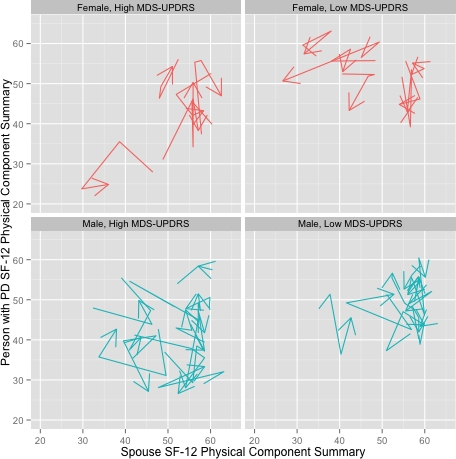Session Information
Date: Monday, June 20, 2016
Session Title: Quality of life/caregiver burden in movement disorders
Session Time: 12:30pm-2:00pm
Location: Exhibit Hall located in Hall B, Level 2
Objective: To demonstrate an innovative visualization method for measuring the interdependence of the health status of people with Parkinson’s disease (PD) and their spouses over time.
Background: People with PD often rely on the instrumental and emotional support of their spouses for carrying out daily activities. Caregiving is often burdensome emotionally and physically debilitating. However, little is known about the relationship between each individual’s health status within a couple living with PD, especially as the disease progresses.
Methods: We used the SF-12 to examine the physical health status of 36 couples living with Parkinson’s disease at each of 4 time points during a 9-month period. We plotted each dyad’s SF-12 score over time to examine their interdependence of health status and to identify periods of relative volatility (rapid, nonlinear health change) or stability of the dyad health status trajectory. In the same plot, we added identifiers of both gender of the person with PD and low versus high MDS-UPDRS total score.
Results: Mean MDS-UPDRS was 59.7 (sd = 21.6). Overall SF-12 physical component summary scores were relatively unchanged over the 4 measurement occasions at means of approximately 46 and 52 (sd = 8.2) for the person with PD and their spouse, respectively. Our visualization method showed that stability was the norm within most dyads as well, but it also allowed us to quickly identify those dyads with significant volatility for further assessment  . In addition, we observed trends, such as higher volatility among those dyads where the spouse had low health status, which will inform future statistical hypothesis testing as data are collected longitudinally.
. In addition, we observed trends, such as higher volatility among those dyads where the spouse had low health status, which will inform future statistical hypothesis testing as data are collected longitudinally.
Conclusions: Our innovative visualization rapidly provides an understanding of both the overall trajectory of a couple’s health status and its volatility over time. Understanding predictors of volatility of health status over time may help to identify dyads for potential need of services that support the couple’s health.
To cite this abstract in AMA style:
F. Noubary, S.D. Gunnery, E.M. Naumova, M. Saint-Hilaire, C.A. Thomas, L. Tickle-Degnen. Measuring interdependence of the health status of people with Parkinson’s disease and their spouses [abstract]. Mov Disord. 2016; 31 (suppl 2). https://www.mdsabstracts.org/abstract/measuring-interdependence-of-the-health-status-of-people-with-parkinsons-disease-and-their-spouses/. Accessed April 21, 2025.« Back to 2016 International Congress
MDS Abstracts - https://www.mdsabstracts.org/abstract/measuring-interdependence-of-the-health-status-of-people-with-parkinsons-disease-and-their-spouses/
